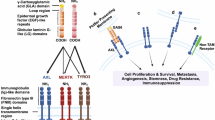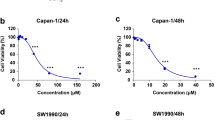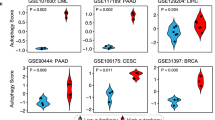Abstract
Aescin, a natural mixture of triterpene saponins, has been reported to exert anticancer effect. Recent studies show that aescin increases intracellular reactive oxygen species (ROS) levels. However, whether the increased ROS play a role in the anticancer action of aescin remains to be explored. In this study, we demonstrated that aescin (20−80 μg/mL) dose-dependently induced apoptosis and activated mammalian target of rapamycin (mTOR)-independent autophagy in human hepatocellular carcinoma HepG2 cells and colon carcinoma HCT 116 cells. The activation of autophagy favored cancer cell survival in response to aescin, as suppression of autophagy with ATG5 siRNAs or 3-methyladenine (3-MA), a selective inhibitor of autophagy, promoted aescin-induced apoptosis in vitro, and significantly enhanced the anticancer effect of aescin in vivo. Meanwhile, aescin dose-dependently elevated intracellular ROS levels and activated Ataxia-telangiectasia mutated kinase/AMP-activated protein kinase/UNC-51-like kinase-1 (ATM/AMPK/ULK1) pathway. The ROS and ATM/AMPK/ULK1 pathway were upstream modulators of the aescin-induced autophagy, as N-acetyl-l-cysteine (NAC) or ATM kinase inhibitor (KU-55933) remarkably suppressed aescin-induced autophagy and consequently promoted aescin-induced apoptosis, whereas overexpression of ATG5 partly attenuated NAC-induced enhancement in aescin-induced apoptosis. In conclusion, this study provides new insights into the roles of aescin-mediated oxidative stress and autophagy in cancer cell survival. Our results suggest that combined administration of the antioxidants or autophagic inhibitors with aescin might be a potential strategy to enhance the anticancer effect of aescin.
Similar content being viewed by others
Log in or create a free account to read this content
Gain free access to this article, as well as selected content from this journal and more on nature.com
or
References
Scherz-Shouval R, Elazar Z. Regulation of autophagy by ROS: physiology and pathology. Trends Biochem Sci. 2011;36:30–8.
Sabharwal SS, Schumacker PT. Mitochondrial ROS in cancer: initiators, amplifiers or an Achilles’ heel? Nat Rev Cancer. 2014;14:709–21.
Moloney JN, Cotter TG. ROS signalling in the biology of cancer. Semin Cell Dev Biol. 2017. https://doi.org/10.1016/j.semcdb.2017.05.023. pii: S1084–9521(16) 30383-4.
He C, Klionsky DJ. Regulation mechanisms and signaling pathways of autophagy. Annu Rev Genet. 2009;43:67–93.
Mizushima N, Komatsu M. Autophagy: renovation of cells and tissues. Cell. 2011;147:728–41.
Kroemer G, Marino G, Levine B. Autophagy and the integrated stress response. Mol Cell. 2010;40:280–93.
Zhang L, Wang K, Lei Y, Li Q, Nice EC, Huang C. Redox signaling: potential arbitrator of autophagy and apoptosis in therapeutic response. Free Radic Biol Med. 2015;89:452–65.
Ni Z, Wang B, Dai X, Ding W, Yang T, Li X, et al. HCC cells with high levels of Bcl-2 are resistant to ABT-737 via activation of the ROS-JNK-autophagy pathway. Free Radic Biol Med. 2014;70:194–203.
Dewaele M, Maes H, Agostinis P. ROS-mediated mechanisms of autophagy stimulation and their relevance in cancer therapy. Autophagy. 2010;6:838–54.
Scherz-Shouval R, Shvets E, Fass E, Shorer H, Gil L, Elazar Z. Reactive oxygen species are essential for autophagy and specifically regulate the activity of Atg4. EMBO J. 2007;26:1749–60.
Schneider JG, Finck BN, Ren J, Standley KN, Takagi M, Maclean KH, et al. ATM-dependent suppression of stress signaling reduces vascular disease in metabolic syndrome. Cell Metab. 2006;4:377–89.
Guo Z, Kozlov S, Lavin MF, Person MD, Paull TT. ATM activation by oxidative stress. Science. 2010;330:517–21.
Alexander A, Cai SL, Kim J, Nanez A, Sahin M, MacLean KH, et al. ATM signals to TSC2 in the cytoplasm to regulate mTORC1 in response to ROS. Proc Natl Acad Sci USA. 2010;107:4153–8.
Zhang J, Tripathi DN, Jing J, Alexander A, Kim J, Powell RT, et al. ATM functions at the peroxisome to induce pexophagy in response to ROS. Nat Cell Biol. 2015;17:1259–69.
Zhang D, Wang W, Sun X, Xu D, Wang C, Zhang Q, et al. AMPK regulates autophagy by phosphorylating BECN1 at threonine 388. Autophagy. 2016;12:1447–59.
Kim J, Kundu M, Viollet B, Guan KL. AMPK and mTOR regulate autophagy through direct phosphorylation of Ulk1. Nat Cell Biol. 2011;13:132–41.
Sirtori CR. Aescin: pharmacology, pharmacokinetics and therapeutic profile. Pharmacol Res. 2001;44:183–93.
Patlolla JM, Raju J, Swamy MV, Rao CV. Beta-escin inhibits colonic aberrant crypt foci formation in rats and regulates the cell cycle growth by inducing p21(waf1/cip1) in colon cancer cells. Mol Cancer Ther. 2006;5:1459–66.
Yuan SY, Cheng CL, Wang SS, Ho HC, Chiu KY, Chen CS, et al. Escin induces apoptosis in human renal cancer cells through G2/M arrest and reactive oxygen species-modulated mitochondrial pathways. Oncol Rep. 2017;37:1002–10.
Tan SM, Li F, Rajendran P, Kumar AP, Hui KM, Sethi G. Identification of beta-escin as a novel inhibitor of signal transducer and activator of transcription 3/Janus-activated kinase 2 signaling pathway that suppresses proliferation and induces apoptosis in human hepatocellular carcinoma cells. J Pharmacol Exp Ther. 2010;334:285–93.
Ji DB, Xu B, Liu JT, Ran FX, Cui JR. beta-Escin sodium inhibits inducible nitric oxide synthase expression via downregulation of the JAK/STAT pathway in A549 cells. Mol Carcinog. 2011;50:945–60.
Zhu J, Yu W, Liu B, Wang Y, Shao J, Wang J, et al. Escin induces caspase-dependent apoptosis and autophagy through the ROS/p38 MAPK signalling pathway in human osteosarcoma cells in vitro and in vivo. Cell Death Dis. 2017;8:e3113.
Xie JM, Li B, Yu HP, Gao QG, Li W, Wu HR, et al. TIGAR has a dual role in cancer cell survival through regulating apoptosis and autophagy. Cancer Res. 2014;74:5127–38.
Galluzzi L, Pietrocola F, Levine B, Kroemer G. Metabolic control of autophagy. Cell. 2014;159:1263–76.
Chauhan S, Goodwin JG, Chauhan S, Manyam G, Wang J, Kamat AM, et al. ZKSCAN3 is a master transcriptional repressor of autophagy. Mol Cell. 2013;50:16–28.
Guo JY, Xia B, White E. Autophagy-mediated tumor promotion. Cell. 2013;155:1216–9.
Seglen PO, Gordon PB. 3-Methyladenine: specific inhibitor of autophagic/lysosomal protein degradation in isolated rat hepatocytes. Proc Natl Acad Sci USA. 1982;79:1889–92.
Mojzisova G, Kello M, Pilatova M, Tomeckova V, Vaskova J, Vasko L, et al. Antiproliferative effect of beta-escin-an in vitro study. Acta Biochim Pol. 2016;63:79–87.
Prasad S, Gupta SC, Tyagi AK. Reactive oxygen species (ROS) and cancer: role of antioxidative nutraceuticals. Cancer Lett. 2017;387:95–105.
Galadari S, Rahman A, Pallichankandy S, Thayyullathil F. Reactive oxygen species and cancer paradox: to promote or to suppress? Free Radic Biol Med. 2017;104:144–64.
Cheng P, Kuang F, Ju G. Aescin reduces oxidative stress and provides neuroprotection in experimental traumatic spinal cord injury. Free Radic Biol Med. 2016;99:405–17.
Harikumar KB, Sung B, Pandey MK, Guha S, Krishnan S, Aggarwal BB. Escin, a pentacyclic triterpene, chemosensitizes human tumor cells through inhibition of nuclear factor-kappaB signaling pathway. Mol Pharmacol. 2010;77:818–27.
Qanungo S, Wang M, Nieminen AL. N-Acetyl-L-cysteine enhances apoptosis through inhibition of nuclear factor-kappaB in hypoxic murine embryonic fibroblasts. J Biol Chem. 2004;279:50455–64.
Acknowledgements
This work was supported by grants from the Jiangsu Provincial Commission of Health and Family Planning (No. YG201402, YG201503), Jiangsu Provincial Medical Youth Talent, (No. QNRC2016249), Suzhou Science and Technology Bureau (No. SYSD2013041, SYSD2016044, SYSD2017041 and SYS201788), Wujiang District Science and Technology Bureau (No. WS201301), Wujiang District Commission of Health and Family Planning (No. WWK201607 and WWK201609) and National Natural Science Foundation of China (No. 81602613).
Author contributions
BL, Z-hQ, G-hS and Q-gG designed the research; BL, ZW, WD and G-lW performed the research; H-yS, X-pS and RZ contributed new reagents or analytic tools; J-mX and ZW analyzed the data; and BL and Z-hQ wrote the paper.
Author information
Authors and Affiliations
Corresponding authors
Ethics declarations
Competing interests
The authors declare that they have no competing interests.
Rights and permissions
About this article
Cite this article
Li, B., Wu, Gl., Dai, W. et al. Aescin-induced reactive oxygen species play a pro-survival role in human cancer cells via ATM/AMPK/ULK1-mediated autophagy. Acta Pharmacol Sin 39, 1874–1884 (2018). https://doi.org/10.1038/s41401-018-0047-1
Received:
Accepted:
Published:
Issue date:
DOI: https://doi.org/10.1038/s41401-018-0047-1
Keywords
This article is cited by
-
Natural autophagy modulators in non-communicable diseases: from autophagy mechanisms to therapeutic potential
Acta Pharmacologica Sinica (2025)
-
Role of Escin in breast cancer therapy: potential mechanism for inducing ferroptosis and synergistic antitumor activity with cisplatin
Apoptosis (2023)
-
Autophagy upregulation as a possible mechanism of arsenic induced diabetes
Scientific Reports (2018)



